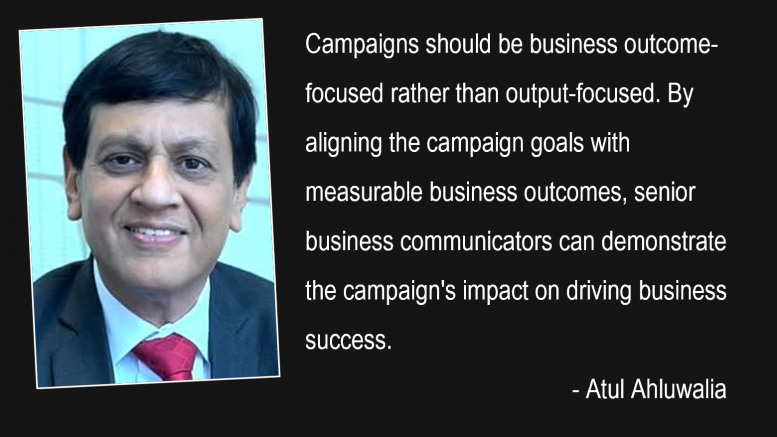In today’s fast-paced and highly competitive business environment, the success of a communications campaign depends on its ability to capture and retain the audience attention and achieve the business goals that necessitated it in the first place. Based on our work over several decades of crafting and delivering campaigns that have worked for our clients, there are seven ‘golden principles’ or guidelines that can help communicators in developing impactful and unforgettable campaigns.
Before diving into the golden principles, it is crucial to lay a solid foundation by adhering to certain prerequisites. Thoroughly understanding the client’s goals, values, and target audience is the first step towards creating a successful campaign. As Steve Jobs once said, “You’ve got to start with the customer experience and work backwards to the technology.” Aligning the campaign with the client’s vision and objectives ensures a focused and coherent message. Additionally, conducting a comprehensive analysis of the competitive landscape allows communicators to identify gaps and opportunities.
Let us now try and understand the seven golden principles for achieving memorable campaigns:
The first principle emphasises thinking multidisciplinary. To break free from traditional approaches, communicators should adopt a multidisciplinary perspective and not confine their perspective to just PR. Integrated campaigns that utilise various communication channels have the potential to leave a lasting impact. For instance, our campaign for JHPIEGO (initially, the Johns Hopkins Program for International Education in Gynaecology and Obstetrics) Campaign — #NursesMidwife4Change– effectively addressed nurses’ poor working conditions by leveraging a combination of expert discussions, partnerships with nurses’ bodies, traditional media and social media-led crowdsourcing campaign.
The second principle highlights the importance of universal appeal. Memorable campaigns transcend boundaries and resonate with diverse audiences across geographies and communities. By linking a specific narrative to a broader concern, campaigns can capture universal appeal. The Sakha Cabs Campaign, “Making Delhi Safer!” successfully addressed the issue of women’s safety in Delhi by connecting it to the city’s overall image and tried to address the universal issue of women’s safety.
The third principle emphasises the need for an emotional core. As Maya Angelou once wisely remarked, “I’ve learned that people will forget what you said, people will forget what you did, but people will never forget how you made them feel.” Campaigns that evoke emotions have a higher chance of becoming memorable. By tapping into the audience emotions, communicators can forge a deeper connection and leave a lasting impression. The Taj Must Smile campaign for USAID created awareness about maternity deaths in India by invoking emotions tied to the story of Shahjahan’s wife, Mumtaj Mahal who had died during childbirth, a condition that afflicts many women even today, and the Taj, a silent and yet sad monument to love, which is still waiting to smile.
The fourth principle focuses on creating multi-layered messaging. Craft campaigns with multi-layered messages that add depth and resonance. By addressing immediate events, brand messages, and national issues simultaneously, communicators can create a more impactful and memorable campaign. The Mangaldeep Temple Run campaign successfully forged a connection between behaviour change, cleanliness, duty, worship, environmental consciousness, and community engagement. By linking the brand equity of the product to the larger theme of ‘Swachh Bharat’, the campaign gained a larger purpose and richer momentum.
The fifth principle emphasises the importance of drilling for deep insights. Uncovering unique and uncharted insights is key to creating campaigns that stand out. By understanding niche aspects of the target audience, communicators can position themselves as leaders in their segment or category. Gillette’s “Women Against Lazy Stubble” campaign tapped into the insight that men value the opposite sex’s views on good looks and hygiene, resulting in a highly successful campaign where the communication was principally directed at women and indirectly impacted men’s attitudes and eventually their buying behaviour.
The sixth principle encourages making campaigns fresh. To avoid monotony and capture attention, campaigns must break away from repetitive, predictive, patterns. Innovating and thinking outside the box is crucial for creating fresh and exciting campaigns. As Albert Einstein once wisely stated, “Creativity is intelligence having fun.” Hyundai India’s “Hyundai Celebrates its Silver Jubilee with India’s Super 25!” campaign stood out by linking the brand’s 25th anniversary to India’s 25 years of growth in a variety of creative ways.
Lastly, campaigns should be business outcome-focused rather than output-focused. By aligning the campaign goals with measurable business outcomes, senior business communicators can demonstrate the campaign’s impact on driving business success. All of the above campaigns achieved significant outcomes, be they in product sales, brand equity incremental, or awareness generation.
While outstanding communication campaigns may excel in creativity, engagement, and resonance, their failure to achieve desired business outcomes often stems from a lack of clear objectives, poor integration with other business functions, insufficient adaptation to changing dynamics, and a disconnect from the target audience. By addressing these underlying challenges, communicators can bridge the gap between excellence and tangible business outcomes, driving the success of their campaigns and unlocking their full potential to create lasting impact.
The views and opinions published here belong to the author and do not necessarily reflect the views and opinions of the publisher.



Be the first to comment on "Crafting Memorable Communication Campaigns: The Seven Golden Principles"